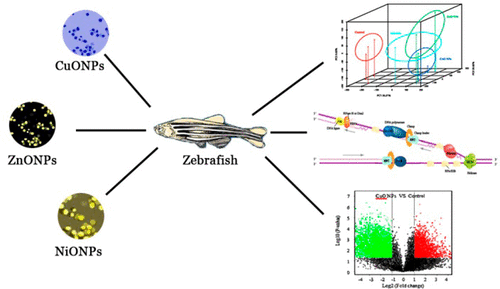当前位置:
X-MOL 学术
›
Environ. Sci. Technol.
›
论文详情
Our official English website, www.x-mol.net, welcomes your feedback! (Note: you will need to create a separate account there.)
Molecular Toxicity of Metal Oxide Nanoparticles in Danio rerio
Environmental Science & Technology ( IF 11.4 ) Pub Date : 2018-07-06 , DOI: 10.1021/acs.est.8b01464 Jing Hou 1 , Haiqiang Liu 1 , Luyao Wang 1 , Linshuai Duan 1 , Shiguo Li 2 , Xiangke Wang 1
Environmental Science & Technology ( IF 11.4 ) Pub Date : 2018-07-06 , DOI: 10.1021/acs.est.8b01464 Jing Hou 1 , Haiqiang Liu 1 , Luyao Wang 1 , Linshuai Duan 1 , Shiguo Li 2 , Xiangke Wang 1
Affiliation

|
Metal oxide nanoparticles can exert adverse effects on humans and aquatic organisms; however, their toxic mechanisms are still unclear. We investigated the toxic effects and mechanisms of copper oxide, zinc oxide, and nickel oxide nanoparticles in Danio rerio using microarray analysis and the comet assay. Copper oxide nanoparticles were more lethal than the other metal oxide nanoparticles. Gene ontology analysis of genes that were differentially expressed following exposure to all three metal oxide nanoparticles showed that the nanoparticles mainly affected nucleic acid metabolism in the nucleus via alterations in nucleic acid binding. KEGG analysis classified the differentially expressed genes to the genotoxicity-related pathways “cell cycle”, “Fanconi anemia”, “DNA replication”, and “homologous recombination”. The toxicity of metal oxide nanoparticles may be related to impairments in DNA synthesis and repair, as well as to increased production of reactive oxygen species.
中文翻译:

金属氧化物纳米颗粒在里约热内卢的分子毒性。
金属氧化物纳米粒子可对人类和水生生物产生不利影响;然而,它们的毒性机制仍不清楚。我们研究了氧化铜,氧化锌和氧化镍纳米粒子在Danio rerio中的毒性作用及其机理使用微阵列分析和彗星分析。氧化铜纳米粒子比其他金属氧化物纳米粒子更具致命性。对暴露于所有三种金属氧化物纳米粒子后差异表达的基因进行的基因本体分析表明,纳米粒子主要通过核酸结合的改变影响细胞核中的核酸代谢。KEGG分析将差异表达的基因分类为与遗传毒性相关的途径,包括“细胞周期”,“范可尼贫血”,“ DNA复制”和“同源重组”。金属氧化物纳米颗粒的毒性可能与DNA合成和修复中的损伤以及活性氧的产生增加有关。
更新日期:2018-07-08
中文翻译:

金属氧化物纳米颗粒在里约热内卢的分子毒性。
金属氧化物纳米粒子可对人类和水生生物产生不利影响;然而,它们的毒性机制仍不清楚。我们研究了氧化铜,氧化锌和氧化镍纳米粒子在Danio rerio中的毒性作用及其机理使用微阵列分析和彗星分析。氧化铜纳米粒子比其他金属氧化物纳米粒子更具致命性。对暴露于所有三种金属氧化物纳米粒子后差异表达的基因进行的基因本体分析表明,纳米粒子主要通过核酸结合的改变影响细胞核中的核酸代谢。KEGG分析将差异表达的基因分类为与遗传毒性相关的途径,包括“细胞周期”,“范可尼贫血”,“ DNA复制”和“同源重组”。金属氧化物纳米颗粒的毒性可能与DNA合成和修复中的损伤以及活性氧的产生增加有关。



























 京公网安备 11010802027423号
京公网安备 11010802027423号